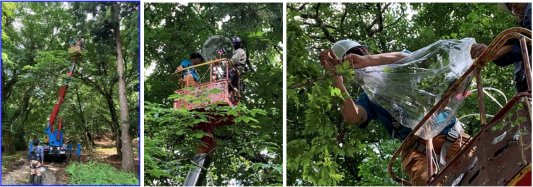研究課題
Methane budget of a complex mountainous forest: look up and down.
複雑地形の森林におけるメタン収支:ルック・アップ・アンド・ダウン
研究組織
| 代表者 | EPRON Daniel, Kyoto University, Graduate School of Agriculture |
|---|---|
| 共同研究者 | TAKAHASHI Kenshi, Kyoto University, RISH SAKABE Ayaka, Kyoto University, Graduate School of Agriculture |
| 関連ミッション |
|
研究概要
CH4 is the second most important anthropogenic greenhouse gas and rise of atmospheric CH4 concentration has accelerated these last years. In addition to global warming, CH4 oxidation in the troposphere leads to ozone production, which is harmful to human health and crop yields. Forests are a well-known carbon sinks, which mitigate the rise in atmospheric CO2 and hence global warming. Soils in upland forests are the largest biological sink for atmospheric CH4, providing a valuable ecosystem service. However, trees emit CH4 and it is necessary to take into account the role of the trees in addition to that of the soil to establish a complete methane balance of a forest ecosystem. For example, trees contribute up to 87% of total ecosystem CH4 flux in a south-east Asian tropical peat forest, and emissions from floodplain trees close the Amazonian CH4 budget. Upland forests cover almost the two-third of the land area in Japan, but little is known about the role of trees in their CH4 budget.
Stem CH4 emission has been measured for two years (from August 2020 to now) in the Ashiu experimental forest (upper Yura River watershed) and we showed that the trunks of the major species at this site emit CH4, with a large variability among species, among trees for a given species, and within a tree. For the vast majority of the trees, CH4 was produced internally and did not originate from the soil.
Our priority will be to continue measuring tree emissions, including not only the lower part of the stem as we did until now, but also the upper part, branches and foliage, which have been overlooked in most studies around the world. We will use a cherry picker to access the upper part of the tree trunks and their foliage, taking advantage of the numerous trees lining the forest dirt roads in our working area.
We will also implement soil CH4 flux measurement on a 2.25-hectare plot covering the topographic heterogeneity of this mountainous forest and including all target trees. The selected study area will be divided into regular 25×25 m squares. Soil collars for CH4 flux measurements will be installed at the four corners of each of the 25×25 m squares, resulting in a total of 49 measurement points. Simultaneously to soil CH4 flux, soil temperature and volumetric soil water content measurements will also be performed at the same 49 positions. The diameter at breast height of all surrounding trees within a radius of 7 m around each of the soil collars, as well as their distance to the collar and their species identity. This sampling design will allow us to investigate the effect of seasonality on the spatial variability and environmental controls of soil CH4 flux.
Tree CH4 emissions will be scaled to stand level based on species-specific relationships between stem diameter, wood traits and CH4 emission, and using stand inventories. Stand level CH4 emission from trees will be compared to spatially averaged soil CH4 flux to estimate the total CH4 budget of the forest.
 Figure 1: A Cherry picker is used to access the upper part of the tree trunks and their foliage in the Ashiu experimental forest
Figure 1: A Cherry picker is used to access the upper part of the tree trunks and their foliage in the Ashiu experimental forest
ページ先頭へもどる
2022年10月4日作成


